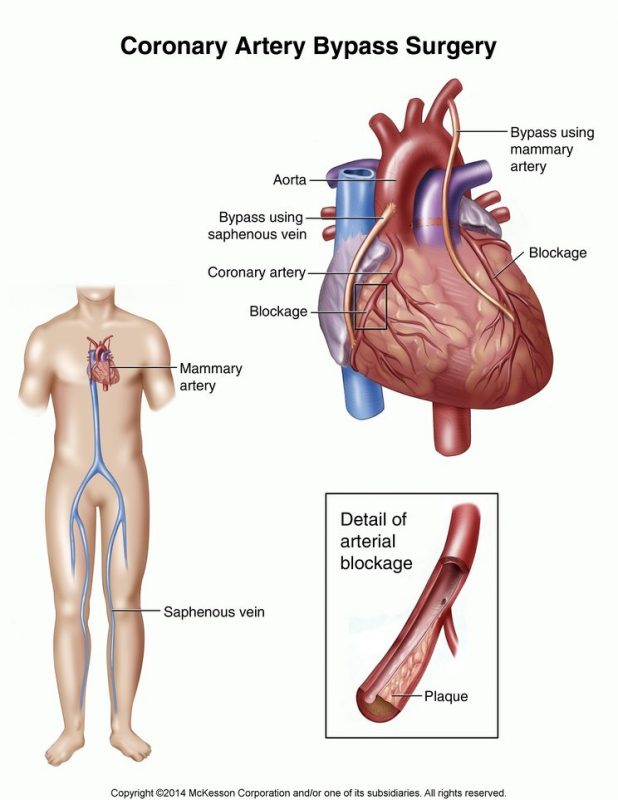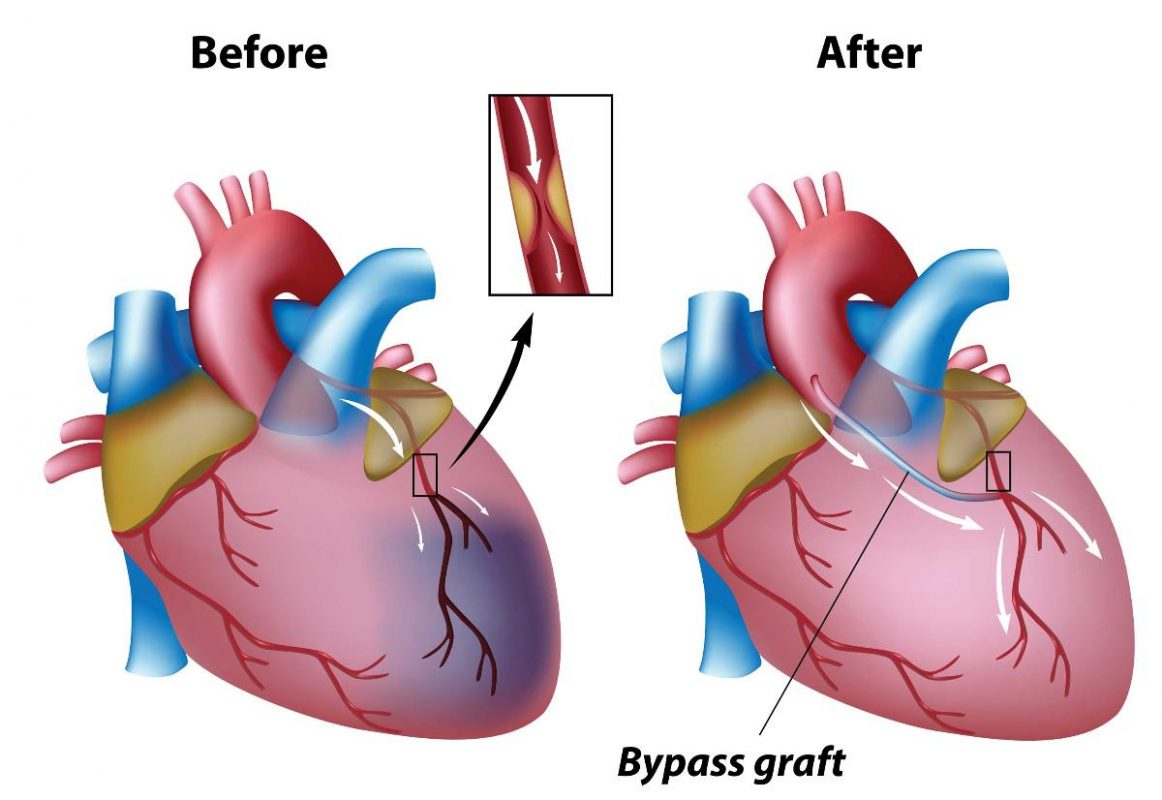What is Coronary Bypass Surgery
Coronary artery bypass graft surgery (CABG) is a procedure which takes a blood vessel from a part of the body to restore blood flow to the heart muscle.
CABG is used for patients who have coronary artery disease (CAD). CAD is due to a disease process called atherosclerosis caused an accumulation of cholesterol, protein, calcium, etc. Collectively, these form what is called plaque within the coronary arteries. Plaque formulates within the arteries therefore, restricts the amount of blood flow to the heart and deprives the heart muscle from oxygen and nutrients causing ischemia. Ischemia can produce symptoms of chest pain (angina) or in more severe cases can produce heart attack (myocardial infarction), heart failure, arrhythmias, or cardiac death.
After CABG surgery, normal blood flow to the heart muscle is restored therefore, chest pain is relieved in the vast majority of patients. CABG can also prolong the survival rate in patients with severe coronary artery disease.
Who needs it?
CABG is recommended for the following:
- Stable angina: this is when the frequency, severity, duration, and precipitating factors of chest pain remain unchanged. CABG is recommended in these patients if symptoms are persisting or remain intolerable despite medical therapy or interventional procedures. Those at high risk of heart attack or death are also recommended for CABG.
- Extensive disease: this includes patients with narrowing of the left main coronary artery, multiple narrowed coronary arteries, or those with a low ejection fraction (poor pumping function of the left ventricle of the heart).
- Future risk of a cardiac event: patients who have had testing done showing that they are at high risk for a future cardiac event, poor exercise capacity, low blood pressure during exercise, or severely restricted blood flow to multiple areas of the heart may require CABG.
- Unstable angina: in patients whose chest pain increases in frequency, becomes more severe, long lasting, present at rest, or does not respond to medical management may require intervention or CABG.
What to expect:
During the procedure:
CABG usually takes anywhere from 3 to 6 hours or more depending on the severity. General anesthesia is required for the surgery.
A large incision will be made over the chest. Blood flow will be passed through a heart-lung machine called an on-pump coronary bypass surgery. After the chest is opened, the heart is temporarily stopped while blood flow is maintained from the heart-lung machine.
A section of a healthy blood vessel either from the internal mammary artery in the chest wall or the saphenous vein in the lower leg will be used as the graft. One end of the vessel will be attached above the blocked artery and the other end will be attached below the blocked artery to go around or bypass the diseased artery.
After the procedure:
Once the surgery is over, the patient will remain in the hospital intensive care unit (ICU) for one to two days. While in ICU the patient’s heart rate and rhythm, blood pressure, temperature, and breathing will be continuously monitored.
- The breathing tube that was placed in the airway before surgery will be removed a few hours after surgery, once the patient is awake and can breathe on their own.
- A thin urinary catheter placed before surgery will be removed once the patient is able to walk and go to the restroom on their own.
- An intravenous (IV) line will be fixed before surgery for the administration of medications, fluid, and blood. Once the patient is able to eat and drink on their own and IV medications are no longer required, the IV line is removed.
- The incision over the chest usually causes the most discomfort in the initial 48 to 72 hours after surgery. Pain medication is usually given to help relieve any pain or discomfort.
After one to two days, the patient is encouraged to start walking. Early ambulation helps prevent the development of clots.
Most patients recover in the hospital for four to five days after surgery, although hospitalization may be longer.
Recovery period is about six to twelve weeks after the surgery. With the doctor’s approval, daily activities can be resumed.

What is minimally invasive bypass surgery?
This is a new technique being developed that may reduce the discomfort and risks associated with traditional bypass surgery.
This uses a small chest incision and the surgery is preformed while the heart is still beating. This technique is becoming increasingly popular, but is not suitable for all cases.
Long term results are comparable to traditional CABG, although a shorter hospital stay is included.
What are the risks?
CABG is an open heart surgery; complications may occur during or after surgery.
The major complications include:
- Bleeding
- Heart attack
- Heart failure
- Arrhythmia
- Stroke
- Changes in cognitive function
- Pulmonary problems
- Chest/wound infection
- Renal failure
- Death
Other complications include:
- Pleural effusion
- Phrenic nerve damage
- Intercostal nerve damage
- Aortic dissection
- Thrombocytopenia
When to call your doctor?
Call your doctor if you have any of the following:
- Fever higher than 100.4°F
- Rapid heart rate
- New onset or worsening pain at wound site
- Redding, discharge, or bleeding from the chest wound
- Shortness of breath
- Fainting
- Weight gain of more than 2 pounds in 24 hours or more than 5 pounds in one week
- Swelling in your hands, feet, or ankles
What is the long term result?
In the long run after CABG surgery, most people feel better and may remain symptom free for as long as 10 to 15 years.
If proper care is not taken, arteries at other sites or even the new graft may become clogged. Symptoms will reoccur and further intervention or another bypass may be required.
The recurrence of angina is less frequently seen with an arterial graft used for bypass compared to a vein.
To prevent the recurrence of angina or the clogging of arteries, lifestyle modifications must be taken.
Lifestyle modifications include:
- No smoking!!!
- Reduce the amount of saturated fats and cholesterol you take. Saturated fats include cheese, butter, milk, and red meats.
- Reduce your salt intake. Season foods with garlic or pepper.
- Add more fruits and vegetables to your diet.
- Try eating fish like cod, salmon, or tuna. These are low in fat and have healthy omega 3 fatty acids.
- Increase fiber in your diet. This helps in lowering cholesterol levels. Eat more whole grain foods like brown rice and oatmeal.
- Reduce your weight. Maintain a BMI below 25.
- Exercise for 30 minutes at least 3-4 times a week and be more physically active.

Begin your recovery by enrolling in a cardiac rehabilitation program for proper cardiac exercise and education. This is a specially designed program for patients recovering from heart attack, from other forms of heart disease, or after surgery to treat heart disease.
Cardiac rehabilitation is usually initiated while in the hospital and is to be continued in an outpatient setting. Maintenance programs can be initiated within a home setting.

